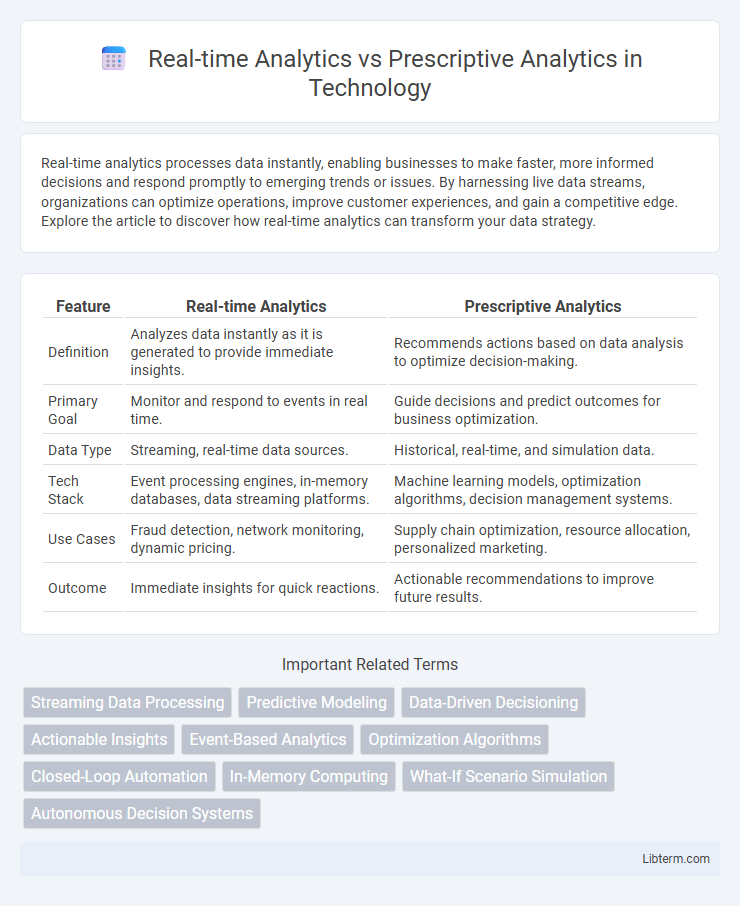Real-time analytics processes data instantly, enabling businesses to make faster, more informed decisions and respond promptly to emerging trends or issues. By harnessing live data streams, organizations can optimize operations, improve customer experiences, and gain a competitive edge. Explore the article to discover how real-time analytics can transform your data strategy.
Table of Comparison
| Feature | Real-time Analytics | Prescriptive Analytics |
|---|---|---|
| Definition | Analyzes data instantly as it is generated to provide immediate insights. | Recommends actions based on data analysis to optimize decision-making. |
| Primary Goal | Monitor and respond to events in real time. | Guide decisions and predict outcomes for business optimization. |
| Data Type | Streaming, real-time data sources. | Historical, real-time, and simulation data. |
| Tech Stack | Event processing engines, in-memory databases, data streaming platforms. | Machine learning models, optimization algorithms, decision management systems. |
| Use Cases | Fraud detection, network monitoring, dynamic pricing. | Supply chain optimization, resource allocation, personalized marketing. |
| Outcome | Immediate insights for quick reactions. | Actionable recommendations to improve future results. |
Understanding Real-time Analytics
Real-time analytics processes data as it is generated, enabling immediate insights and quick decision-making for dynamic environments such as financial trading or fraud detection. It relies on streaming data technologies and in-memory computing to analyze large volumes with minimal latency. Understanding real-time analytics is essential for businesses seeking to enhance operational efficiency and respond promptly to changing conditions.
What is Prescriptive Analytics?
Prescriptive analytics uses advanced algorithms, machine learning, and optimization techniques to recommend specific actions based on real-time and historical data analysis. It goes beyond descriptive and predictive analytics by providing decision-makers with actionable insights to achieve desired outcomes and improve operational efficiency. By integrating data from various sources, prescriptive analytics helps organizations identify the best course of action under multiple scenarios and constraints.
Key Differences Between Real-time and Prescriptive Analytics
Real-time analytics processes data instantly to provide immediate insights for timely decision-making, focusing on monitoring current events and detecting anomalies as they occur. Prescriptive analytics goes beyond by utilizing advanced algorithms, simulations, and optimization techniques to recommend specific actions and predict future outcomes based on historical and real-time data. The key difference lies in real-time analytics' emphasis on data velocity and situational awareness, while prescriptive analytics centers on decision guidance and strategic planning through predictive modeling.
How Real-time Analytics Drive Immediate Decision-Making
Real-time analytics processes data instantly as it is generated, enabling businesses to respond to events without delay and optimize operations on the spot. By providing up-to-the-minute insights through continuous data monitoring, real-time analytics supports quick identification of anomalies, trends, and opportunities. This immediate access to actionable information enhances decision-making speed, reduces risks, and improves customer experiences across industries such as finance, healthcare, and retail.
The Role of Prescriptive Analytics in Strategic Planning
Prescriptive analytics plays a crucial role in strategic planning by recommending specific actions based on real-time data insights and predictive models. Unlike real-time analytics, which focuses on monitoring current events and generating immediate insights, prescriptive analytics integrates multiple data sources to optimize decision-making and forecast outcomes. This approach enables organizations to proactively allocate resources, mitigate risks, and achieve long-term business objectives through data-driven strategies.
Use Cases for Real-time Analytics
Real-time analytics is crucial for use cases requiring immediate decision-making, such as fraud detection in banking, real-time customer experience personalization in e-commerce, and network performance monitoring in telecommunications. These applications benefit from instantaneous data processing to identify patterns, anomalies, or opportunities as they arise, enabling businesses to act swiftly. Unlike prescriptive analytics, which focuses on providing recommendations based on historical data, real-time analytics emphasizes speed and responsiveness in dynamic environments.
Practical Applications of Prescriptive Analytics
Prescriptive analytics leverages advanced algorithms and machine learning to provide actionable recommendations, optimizing decision-making in industries like supply chain management, healthcare, and finance. Real-time analytics focuses on immediate data interpretation for operational monitoring, while prescriptive analytics goes further by simulating scenarios and suggesting best courses of action based on predictive insights. Companies use prescriptive analytics to improve resource allocation, enhance customer experience, and increase efficiency by anticipating outcomes and recommending proactive strategies.
Benefits and Challenges of Real-time Analytics
Real-time analytics offers immediate insights by processing data as it arrives, enabling businesses to make swift, data-driven decisions that enhance operational efficiency and customer experiences. Key benefits include timely detection of anomalies, improved responsiveness to market changes, and the ability to optimize processes on the fly. However, challenges involve handling large data volumes with low latency, ensuring data accuracy in rapid processing, and the significant infrastructure investment required to support real-time systems.
Advantages and Limitations of Prescriptive Analytics
Prescriptive analytics offers the advantage of providing actionable recommendations by analyzing data trends and predicting future outcomes, improving decision-making efficiency across industries such as healthcare, finance, and supply chain management. Limitations include reliance on the quality and accuracy of input data, the complexity of modeling scenarios, and the potential for high computational costs, which can hinder real-time application and adaptability. Despite these challenges, prescriptive analytics delivers significant value by optimizing strategies and resource allocation based on predictive insights.
Choosing the Right Analytics Approach for Your Business
Selecting the right analytics approach depends on your business objectives and data maturity; real-time analytics excels in monitoring live operations and responding instantly to events, enhancing decision speed and operational efficiency. Prescriptive analytics leverages advanced algorithms and machine learning to recommend optimal actions based on predictive insights, driving strategic planning and resource optimization. Assessing factors like data infrastructure, industry demands, and decision-making complexity ensures alignment with either real-time responsiveness or actionable future-oriented guidance for maximum business impact.
Real-time Analytics Infographic

 libterm.com
libterm.com